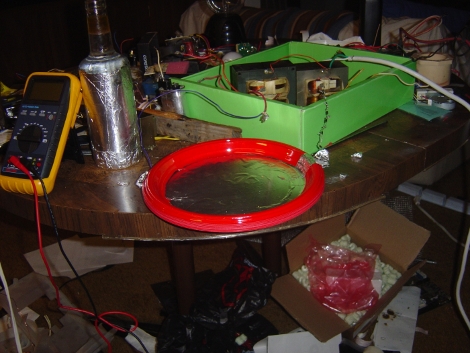
We have been featuring some home made capacitors this week, and [Mike] wrote in to share his with us. While rolled capacitors are nice, they can be somewhat difficult to construct and grow to unwieldy sizes as capacitance and voltages increase. His solution is to stack the layers up using plastic plates.
In this forum post he explains that using disposable plastic plates and tinfoil you’re able to quickly make a capacitor, that for him was valued at around 12.2nF, using eleven layers . Applying pressure to the stack capacitance grew to about 14nF, though he is having a bit of trouble holding it with just glue.
Testing was conducted with high voltages charging the capacitor up, then its leads were shorted for a nice spark and a good pop. Definitely fun for the next family cook out, though we don’t know how some left over potato salad goo would effect the end results.
















Seems like DIY capacitors should be a right of passage project (among others) for EE students.
I remember building HV beer-bottle caps in High School.
I remember making capacitors with plastic drinking cups in Physics II in high school. Fun times: charge it up, throw it at a friend who isn’t in Physics (or one that is, either was hilarious)
Ok, Kudos for making capacitors. but those are a couple of microwave transformers in the background there, I pray you know what you are doing. 2,000 volts at 5 to 8 amps kills quickly.
Capacitor fever at hack-a-day.
Next week — knit your own diodes
I also did a double take with the series MOTs. He has them set apart with the box, so I think he has an idea what he is doing.
tater salad goo would convert it into an electrolytic capacitor, which would be leaking and therefore its capacity diminished.
I can’t remember where I saw the pic. but At one point during the initial development and utilization of radio, they were building transmitters with HUGE HALLS and filling those halls with parallel plates to create the needed capacitance at the many kV they were running at.
This pic showed a man standing at the base of one of these plates, a sheet >20ft wide and 80ft tall!
hehe potato…potato POTATO SALAD…OF COURSE!!!!
(runs from the room)
The capacitor was roughly 12.2nF
“though he is having a bit of trouble holding it with just glue.”
Clamp the plates, like if you are making a laminate.
Lookie here for an absolutely fascinating account of the construction of a radio in a WWII Japanese POW camp: http://histru.bournemouth.ac.uk/CHiDE/Oral_History_of_Defence_Electronics/r_g_wells.htm
The prisoners manufactured capacitors, resistors and an AC-DC rectifier all from things they could steal from around the camp!
Amazing story thanks for the tip Mousefinder!